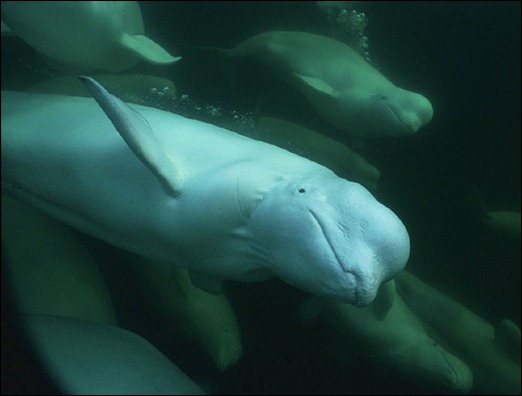A Wonderful ‘New’ Monkey
Just gaze at this remarkable face. Although the Lesula is known to the people of Africa’s remote Lomami forest, she’s new to Western scientists. And her…
 Is the Stock Market a Global Ponzi Scheme?
Is the Stock Market a Global Ponzi Scheme?
 Sacred Activism in the Service of Animals
Sacred Activism in the Service of Animals
 Of Humans and Persons
Of Humans and Persons
Just gaze at this remarkable face. Although the Lesula is known to the people of Africa’s remote Lomami forest, she’s new to Western scientists. And her…
The following extensive notes are from Naomi Rose at Humane Society International, who will be testifying at the permit hearings. A complete pdf of these notes, along with queries for the aquarium and the National Marine and Fisheries Service, which authorizes permits, can be downloaded here, along with information for obtaining complete source materials.
These are questions that can be posed to the Georgia Aquarium about their capture of 18 beluga whales for import into the United States:
All the permit application materials regarding the Georgia Aquarium’s beluga import permit application are available at the website of the federal NOAA/NMFS agency. You can submit comments there. And you can contact the the Georgia Aquarium as follows:
In the 1970s, psychologist Elisabeth Kubler-Ross explained that when we suffer the death of a loved one, we go through five stages of grief. This process…
I love Mars missions and going to the Moon, and looking for life on Europa and Enceladus. But let’s leave nonhuman earthlings on Earth, where they…
(Part Seven of this series.) Gaining a permit to bring dolphins and whales into captivity involves negotiating a thicket of legal, moral and public relations issues. The captivity hasn’t tried this for almost 20 years. If the Georgia Aquarium succeeds with the belugas they’ve captured in Russia, it will open the door to a flood of new imports for the marine zoos and circuses. At a public hearing, Naomi Rose of Humane Society International will be arguing the case for returning those belugas to their homes and families.
Deer are shot and left to die, baby bears left for nature to “take its course.” The horror stories from Marineland at Niagara Falls keep tumbling…
(Sixth in the series.) When she was two years old, a lonely orphan beluga began making friends with fishermen and tourists in Chedabucto Bay, Nova Scotia. But as she became habituated to humans and boats, she was injured several times by propellers. And instead of learning to be part of a beluga family, she was learning to sound like a propeller and to mimic the human children who were calling out to her.
It’s a first in modern legal history: A river in New Zealand has been recognized as a legal person having certain rights and interests. Under a…
(Fifth in our series about beluga whales in captivity.) They’re cute, charming, chatty, curious and all-round delightful. And that’s their problem – it makes them prime targets of the captivity industry that can make money by putting them on show. Dr. Lori Marino is a neuroscientist who specializes in the cognitive abilities of whales and dolphins, elephants, primates and other animals. We asked her about the brains and smarts of belugas.
Do birds of a feather hold their own version of a funeral service? Or when scrub-jays gather round one of their own who has died, with…
I once talked with Mr. Blackwell, the fashion critic who published the annual “Ten Worst Dressed Women”list (and the book “From Rags to Bitches”.) He supported…
(Fourth in a series on belugas in captivity.) Samantha Berg worked with the belugas at SeaWorld in the 1990s. Today, she is an outspoken critic of the captivity industry and a frequent expert guest on radio and TV shows. We talked with her about what it’s like for belugas in captivity, about their life in the wild, and about her time at SeaWorld with Shadow, Spooky, A.J. and Bandit. (While belugas in the wild can live well into their sixties, all four of the ones she knew at SeaWorld have since died.)
Four years of hard work finding homes for dogs, cats and other homeless pets at the Shelby County animal shelter never won a word of applause from PETA. But the prospect of this no-kill shelter getting out the death potion once again had PETA calling for a celebration. They sent a basket of cookies to congratulate the shelter on deciding they might need to kill some of the animals.
(Third in a series on belugas in captivity.) One day in 1861, 11-year-old Sarah Putnam wrote in her diary: “I went again to the Aquarial Gardens and there we saw the Whale being driven by a girl. She was in a boat and the Whale was fastened to the boat by a pair of reigns and a collar, which was fastened round his neck. The men had to chase him before they could put on the collar.” What Sarah had seen that day was one of the first beluga whales to be captured and put on display in the United States.
(Second in a series on belugas in captivity.) Tales of belugas stretch back thousands of years. A 6,000-year-old rock carving in northwest Russia shows a woman, perhaps a shaman, communicating with a beluga whale. A Medieval Christian legend tells of a white horse being resurrected as a beluga. But today, many scientists believe that belugas may be our best hope when it comes to trying to establish language-based communication with other animals.
Jeffrey Gettleman of the New York Times begins a series of reports on the war between elephant poachers and wildlife authorities in the Democratic Republic of…
A stowaway kitten who survived three weeks without food or water in a shipping container bound from China to Los Angeles has a new home. Ni…

The captivity industry’s assault on the world’s cutest whales The Georgia Aquarium has applied for a permit to import 18 beluga whales from Russia into the…